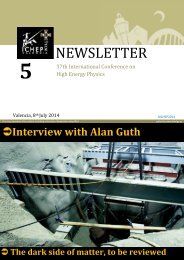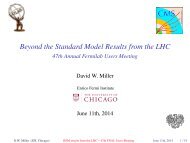PW_mar13_sample_issue
PW_mar13_sample_issue
PW_mar13_sample_issue
You also want an ePaper? Increase the reach of your titles
YUMPU automatically turns print PDFs into web optimized ePapers that Google loves.
Quantum frontiers: Quantum simulation<br />
3 Controlling single spins in an optical lattice<br />
50<br />
a b<br />
y<br />
x<br />
addressing laser beam<br />
atoms in 2D optical lattice<br />
microwave<br />
6.8 GHz<br />
For example, if we send a laser beam in the reverse<br />
direction through the high-resolution microscope<br />
objective, we can focus the beam onto single sites of<br />
the lattice and selectively flip the spin states of each<br />
atom (in other words, between different hyperfine<br />
spin states) in the microscopic array. By moving the<br />
beam along a controlled pathway, an arbitrary spin<br />
pattern can thereby be imprinted onto the gases.<br />
The spin-flipped atoms can be made visible by first<br />
removing the unaffected (non-addressed) atoms<br />
and then imaging the remaining (addressed) ones.<br />
Examples of such single-atom spin orderings can be<br />
seen in figure 3. Once these spin patterns have been<br />
prepared, they could form the initial conditions for<br />
observing interesting non-equilibrium dynamics.<br />
For example, one can track the motion of a singleparticle<br />
impurity in the many-body system, observe<br />
the dynamics of domain walls between regions of<br />
different magnetization, or track the collision of two<br />
spins at energies of a few pico-electron volts. The<br />
possibilities for interesting configurations abound.<br />
Artificial fields<br />
Another condensed-matter problem that ultracoldatom<br />
researchers have long wanted to simulate concerns<br />
the effect of a magnetic field on the electrons<br />
in a 2D electron gas. For a single electron moving in<br />
free space, the presence of a magnetic field with a<br />
component perpendicular to the electron’s direction<br />
of motion creates a Lorentz force that pulls the electron<br />
into a circular “cyclotron” orbit. If the electron<br />
y<br />
x<br />
physicsworld.com<br />
(a) Controlling the spins of atoms in an optical lattice requires a laser beam to “address” the atoms as well as a microwave field. When this addressing laser beam is<br />
focused onto a single atom, it shifts the frequency of a transition between two spin states of the atom. If the frequency of the microwave field is set so that it is<br />
resonant with this shifted transition frequency, only the addressed atoms will have their spins flipped when the field is applied. By moving the addressing beam to<br />
different lattice sites, arbitrary spin patterns at the single-spin level can be prepared (b–c). Such precise control of spin patterns is a crucial first step to a number of<br />
interesting experiments, including the creation of a practical, scalable quantum computer using ultracold atoms.<br />
c<br />
2 μm<br />
is instead moving through a conductor, this same<br />
Lorentz force produces a voltage difference across<br />
the conductor – the Hall effect. But when a 2D electron<br />
gas in a very pure semiconductor at very low<br />
temperatures is exposed to a magnetic field, something<br />
more dramatic can happen: the Hall effect<br />
becomes a quantum phenomenon, with the conductance<br />
in the semiconductor equal to ν e 2 /h. The coefficient<br />
ν can take either integer or fractional values,<br />
and the fractional quantum Hall effect, in particular,<br />
remains a hot topic in condensed-matter research<br />
more than 30 years after its discovery. However, a<br />
severe problem exists in trying to simulate such physics<br />
with ultracold atomic gases: because atoms are<br />
neutral, they do not experience any Lorentz force in<br />
a magnetic field. One might expect that this would<br />
prevent quantum-Hall-type effects from being realized<br />
in an ultracold-atom system, but in fact there<br />
may be a way around this problem.<br />
To understand how we might overcome such an<br />
apparently fundamental difficulty, let us take a closer<br />
look at what, on a quantum-mechanical level, the<br />
effect of a magnetic field, B, on a charged particle<br />
really is. When an electron encircles an area with an<br />
enclosed magnetic flux, its wavefunction acquires a<br />
phase shift. This is known as the Aharonov–Bohm<br />
phase, and its value is given by φ AB = 2π Φ/Φ 0 where<br />
Φ is the flux enclosed in the trajectory of the electron<br />
and Φ 0, the magnetic flux quantum, is equal to the<br />
ratio of Planck’s constant to the charge on an electron.<br />
The quantum-mechanical effect of the mag-<br />
Physics World March 2013<br />
I Bloch, MPQ








